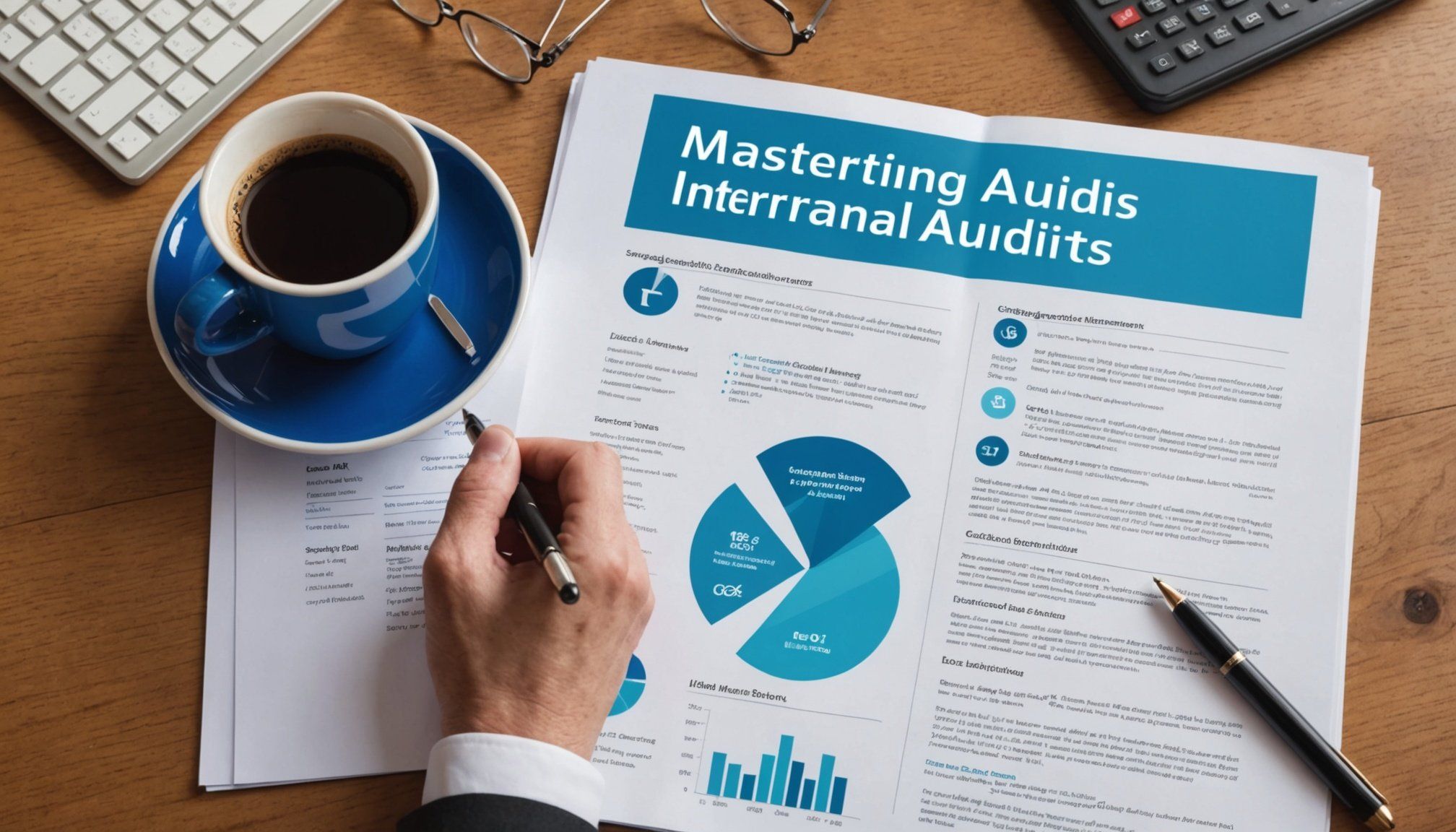Understanding the Internal Audit Process
In the context of UK businesses, the internal audit process plays a pivotal role in ensuring alignment with the country’s comprehensive legal framework and stringent compliance standards. These audits are not merely procedural requirements; they are strategic operations designed to mitigate risks and enhance operational efficiency. Internal audits are crucial for businesses aiming to thrive within the complex landscape of UK regulations.
The necessity of aligning audits with legal compliance cannot be overstated. By doing so, organizations safeguard themselves against potential breaches that could lead to severe financial and reputational consequences. This alignment ensures that businesses operate within the bounds of the law, thus fostering an environment of trust and transparency.
Also to see : Ultimate uk business handbook: mastering trademark law to protect your brand
The key components of an effective internal audit process include detailed planning, risk assessment, execution, and follow-up. Each phase must be meticulously structured to address specific compliance concerns and operational inefficiencies. A well-defined audit process thus becomes an invaluable tool for continuous improvement and strategic decision-making. Embracing these elements not only enhances compliance with the UK legal framework but also promotes a culture of accountability and diligence within UK businesses. An effective internal audit process is a symbol of resilience and a commitment to ethical governance.
Legal Requirements for Internal Audits in the UK
Navigating the UK Legal Requirements for internal audits is essential for any business aiming to maintain compliance and avoid penalties. Several pivotal laws dictate the conduct of audits, ensuring they align with both Compliance Obligations and Regulatory Standards.
Have you seen this : Essential Legal Strategies for UK Businesses to Combat Confidentiality Breaches Effectively
Overview of Relevant Legislation
The Companies Act 2006 is one of the fundamental pieces of legislation guiding audit operations within the UK. It specifies the responsibilities and powers of auditors, ensuring that businesses maintain transparency in their financial reporting. Beyond this, regulations such as the Data Protection Act require auditors to handle personal data with care.
Key Regulatory Bodies
To uphold these Regulatory Standards, bodies like the Financial Reporting Council (FRC) play a critical oversight role. The FRC sets the benchmark for audit quality, ensuring standards are not merely met but exceeded. Their guidance is invaluable for auditors seeking to navigate complex legal landscapes.
Implications of Non-Compliance
Non-adherence to these Compliance Obligations can result in significant consequences, including financial penalties and reputational damage. Such repercussions underline the importance of aligning internal audits with regulatory requirements to ensure long-term business sustainability.
Developing an Internal Audit Strategy
Establishing a robust Audit Strategy is critical for the successful execution of internal audits within UK businesses. The initial step involves assessing organizational needs to ensure that the Planning Internal Audits phase aligns with business objectives. This assessment encompasses a review of current operations and identifying areas vulnerable to risk.
Once needs are understood, the next focus is on clearly establishing objectives and the scope for internal audits. This requires setting specific goals that the audit aims to achieve, such as compliance validation or operational efficiency improvements. A defined scope ensures that audits are comprehensive yet focused, preventing resource wastage.
Incorporating Risk Assessment into the audit strategy becomes indispensable. By evaluating potential risks beforehand, businesses can prioritize areas that require urgent attention, making the audit process more efficient and impactful. It also prepares the organization to manage unforeseen challenges.
Emphasizing these components fosters an environment where audits are not only about compliance but are viewed as an integral part of strategic management. This proactive approach ensures that audits continuously add value, helping UK businesses navigate the complex regulatory landscape effectively.
Step-by-Step Guide to Conducting Internal Audits
Successfully conducting internal audits within UK businesses involves following a structured audit methodology that adheres to best practices. The process begins with meticulous preparation and planning. A well-defined plan reflects an understanding of the business environment and sets the framework for the audit’s objectives and scope. Engaging relevant stakeholders early ensures transparency and fosters an environment conducive to cooperation throughout the audit.
Execution of the audit necessitates following the set methodology rigorously. It’s crucial to gather evidence systematically and evaluate it against compliance standards. This phase requires effective communication amongst the audit team to discern any deviations from expected norms. Best practices recommend maintaining an objective stance, ensuring findings are impartial and reliable.
The final phase—reporting and follow-up—is vital for translating audit insights into actionable improvements. The audit report should be clear, comprehensive, and convey results effectively to stakeholders, highlighting areas of compliance and those needing attention. Follow-up actions are not mere formalities; they are essential for implementing improvements and fostering accountability. By diligently following these steps, businesses ensure their internal audits are efficient, impactful, and aligned with broader strategic aims.
Common Challenges in Internal Auditing
The landscape of internal auditing in UK businesses is often fraught with audit challenges that require adept handling. One recurrent issue is navigating the complexities of risk management, ensuring that audits effectively identify and prioritize risks without overwhelming the audit team. Another frequent challenge is addressing compliance issues, especially amid ever-changing regulations. Businesses must stay proactive to ensure their processes are up-to-date with the UK legal framework and compliance standards.
Resistance to audit processes is another hurdle, often stemming from a lack of understanding or fear of change within organizations. Overcoming this resistance is crucial for developing a culture of transparency and accountability. Strategies to mitigate this challenge include robust communication plans and involving key stakeholders early in the audit process, increasing buy-in and cooperation.
Continuous improvement is vital for effective auditing. By regularly assessing and refining audit practices, businesses can address inefficiencies and enhance their internal audit processes. Internal audits should not be static but evolve to meet the dynamic business environment. Leveraging technology, such as automated audit tools, can provide real-time insights and streamline operations, positioning businesses to better manage their audit challenges and compliance obligations.
Tools and Resources for Effective Internal Auditing
Maximising efficiency in the Internal Audit Process involves utilising the right Audit Tools, Checklists, and Templates. These resources are essential for navigating the UK Legal Framework and maintaining alignment with Compliance Standards.
Recommended Software Solutions
Investing in software solutions that offer features like risk assessment and compliance tracking can bolster your auditing efforts. Look for platforms that provide real-time data analysis and reporting capabilities, as these assist in making informed decisions quickly. Additionally, user-friendly interfaces and integration capabilities are a plus, as they simplify the auditing process.
Useful Checklists for Compliance
Having comprehensive checklists streamlines the audit, ensuring nothing is overlooked. These lists should include all necessary compliance requirements specific to the UK, covering key areas from data protection to financial reporting. An effective checklist becomes indispensable for staying up-to-date and thorough.
Template Examples for Audit Reporting
Utilising templates for audit documentation simplifies the reporting stage, offering consistency and clarity. Templates should be adaptable but include essential sections for findings, compliance status, and suggested follow-ups. By standardising reporting, auditors can more easily communicate their insights to stakeholders, enhancing the overall accountability and transparency of the internal audit process.
Case Studies and Real-life Examples
Exploring Audit Case Studies offers valuable insights into successful internal audit implementations within UK businesses. By observing these real-life scenarios, organizations can identify best practices that may be applicable to their unique circumstances. For instance, a prominent retail chain leveraged advanced analytical tools to enhance its audit efficiency, resulting in improved compliance and risk management outcomes. This case underscores the transformative potential of integrating technology into auditing processes.
Conversely, examining common mistakes in past audits can be equally enlightening. Consider an instance where a UK financial institution faced significant repercussions due to inadequate preparation for regulatory changes. This highlights the pivotal role of staying current with evolving compliance trends and ensuring comprehensive risk assessments are routinely conducted.
From these studies, key takeaways emerge, such as the importance of tailored audit strategies that align with the specific demands of the UK legal environment. Each case illustrates the necessity of flexibility in auditing processes and the value of continuous learning. Businesses can harness these lessons to refine their internal audits, paving the way for enhanced governance and compliance in future endeavours.
Future Trends in Internal Auditing
The Future of Internal Auditing is poised for transformation, particularly with the integration of emerging technologies. In UK businesses, the adoption of advanced digital tools promises to revolutionise auditing practices. This progression enables more proactive and precise auditing processes, enhancing the detection of compliance trends and anomalies in real time.
Impact of Technology on Auditing
Technological advancements, such as AI and data analytics, are redefining the auditing landscape. These tools offer robust data processing capabilities, enabling auditors to perform evolving practices with greater efficiency. By analysing vast datasets, auditors can uncover insights that traditional methods may overlook, thus improving audit accuracy and effectiveness.
Anticipated Regulatory Changes
With technological integration comes the anticipation of regulatory updates. The evolving roles of auditors necessitate staying abreast of impending compliance trends. Regulatory bodies are expected to introduce guidelines aligned with technological capabilities, requiring auditors to be adaptable and forward-thinking.
Evolving Roles of Auditors
As the internal auditing field evolves, so do the roles and required skill sets of auditors. A focus on analytical skills, technological fluency, and strategic thinking is paramount. Auditors must be capable of leveraging technology to enhance compliance monitoring, paving the way for more dynamic and impactful audits.











